Table of Contents
ToggleTypes of Lights Used in Equine Arenas
Flood Lights for Outdoor Horse Arenas
For outdoor horse arenas, flood lights are essential for providing ample illumination. These lights come in various wattages, including 200W, 400W, 1000W, and 1500W, and are designed to cover a broad area with a large beam angle. Flood lights with these specifications are particularly useful for close-range lighting, which is crucial for detailed observation of horse movements. This lighting helps judges evaluate performance accurately and enhances visibility for spectators. The appropriate wattage and number of flood lights depend on the size of the arena, ensuring that both the judges and audience have a clear view of the horses.
Spotlights
Spotlights, especially when mounted on tall masts, are recommended for long-range illumination. These lights typically have a small beam angle and are positioned high above the arena to minimize direct glare and provide extensive coverage. When horses are not performing, spotlights offer unobtrusive lighting that facilitates practice sessions and allows trainers to closely monitor muscle movement and elasticity. This type of lighting is particularly useful for night training, enabling horses to acclimate to nighttime conditions.
Solar Lights
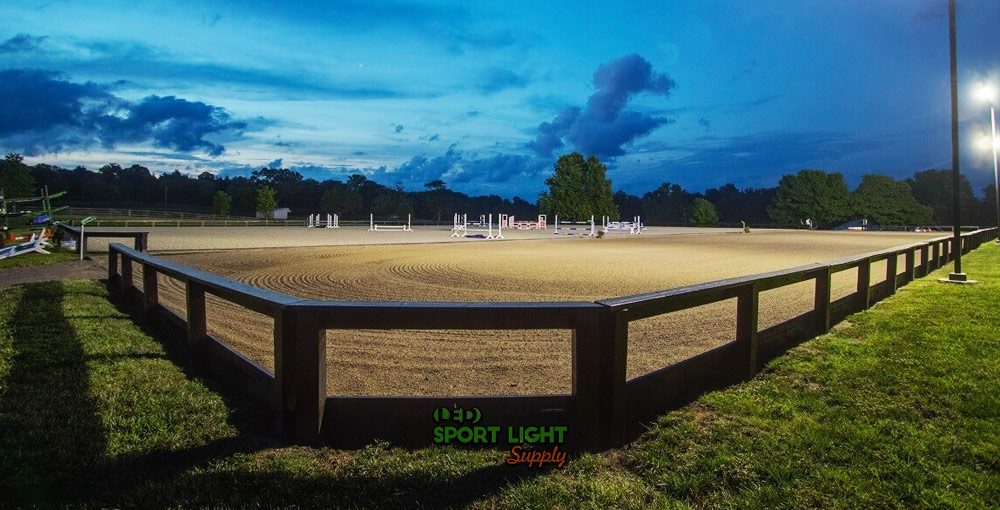
Solar lights present a sustainable option for outdoor equine arenas. These lights rely on solar panels to collect and store energy during the day, which is then used to illuminate the arena at night. This method significantly reduces electricity costs and simplifies installation. However, solar panels need regular cleaning to remove dust and debris, ensuring they continue to operate efficiently. Solar lights are an excellent choice for those seeking an eco-friendly and cost-effective lighting solution.
High Mast Lights
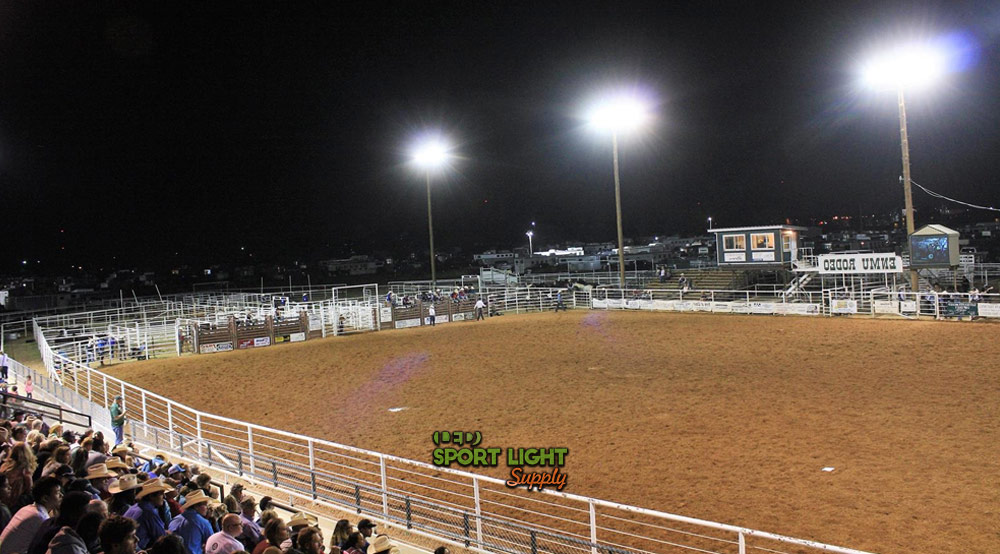
High mast lights are suited for large outdoor arenas where extensive illumination is needed. These lights are mounted on poles ranging from 6 to 18 meters in height, positioned at the corners of the arena. Due to the elevated placement, high mast lights must have powerful fixtures to compensate for the distance and potential light loss. They are ideal for large performance arenas, where they provide adequate lighting for both the horses and the spectators.
High Bay Lights for Indoor Riding Arenas
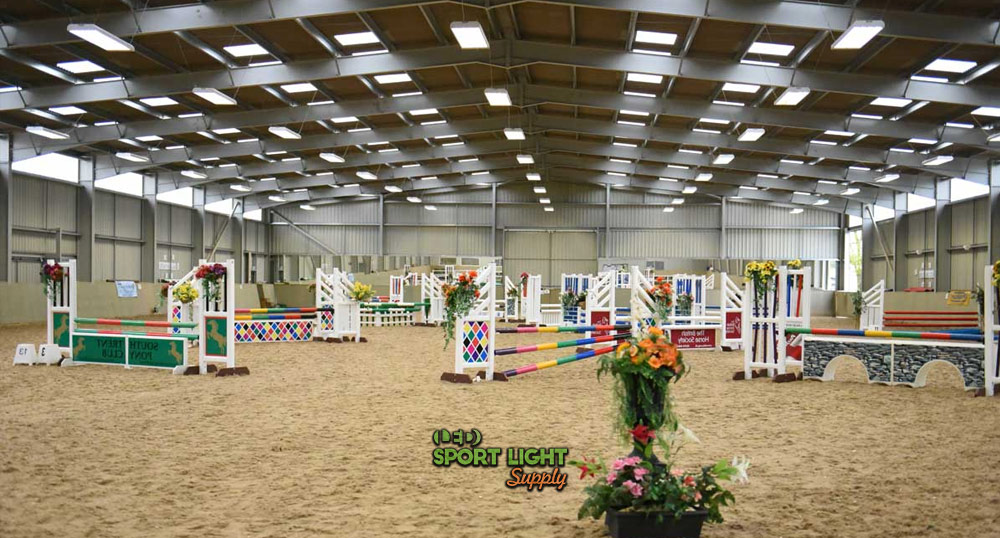
Indoor riding arenas require high bay lights to ensure proper illumination. These lights are installed on the ceiling and directed downward, with their beam angle adjusted according to the height of the ceiling. High bay lights are arranged in a grid pattern, tailored to the dimensions of the arena. This setup provides uniform light coverage across the arena, enhancing visibility and ensuring that every area of the arena is well-lit.
| Type of Light | Features | Ideal Use |
|---|---|---|
| Flood Lights | Large beam angles, various wattages (200W to 1500W) | Close-range observation and performance evaluation |
| Spotlights | Small beam angle, high-mounted | Long-range illumination, night training |
| Solar Lights | Solar-powered, reduces electricity costs | Eco-friendly, low-maintenance lighting solution |
| High Mast Lights | Tall poles (6 to 18 meters), powerful fixtures | Large outdoor arenas, extensive coverage |
| High Bay Lights | Ceiling-mounted, adjustable beam angles, grid setup | Indoor arenas, uniform light coverage
|
Goals of Horse Arena Lighting
Bright Lighting for Equestrians
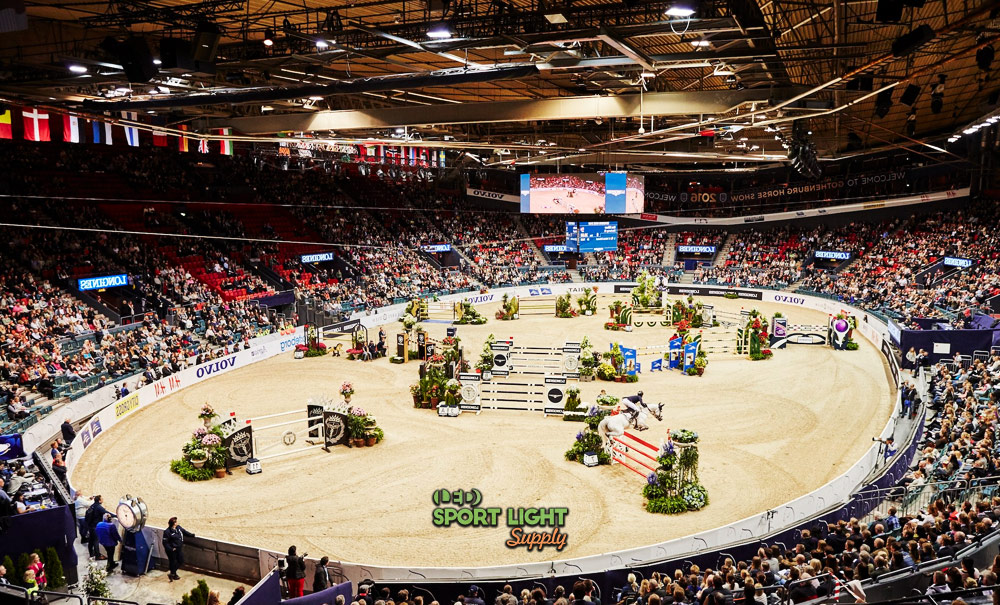
Bright lighting is crucial for showcasing equestrian riding skills during performances and competitions. The aim is to provide illumination that highlights the special skills of horses without causing glare or discomfort. Proper lighting enhances the visibility of attributes such as quality, purity, and obedience, which are essential for accurate judging. For official events and competitions, it is common to use brighter lights to ensure that horses and their performances are clearly visible. This enhanced lighting is also beneficial for photographers and TV cameras covering these events, as it ensures high-quality visuals.
For the Horses’ Health
The lighting in a horse arena can affect the health and performance of horses. Horses respond differently to various types of light, so it is important to choose lighting that supports their well-being while performing. While horses are not highly sensitive to sunlight, appropriate lighting levels can aid them in navigating the arena more effectively. It is essential to balance light intensity to avoid overwhelming them while ensuring that they can see well during their routines. Recommended lighting levels vary depending on whether the arena is used for everyday training or professional events.
Security
Security is a significant concern in horse arenas, given the value of the horses and equipment. Effective lighting can act as a deterrent to potential threats, including predators and thieves. Bright lights are essential for maintaining a secure environment, and motion sensor lights on high poles provide an added layer of protection. These lights activate instantly when motion is detected and can be set on a timer for additional security. Strategic placement of these lights around entrances to stables and barns enhances the overall safety of the facility.
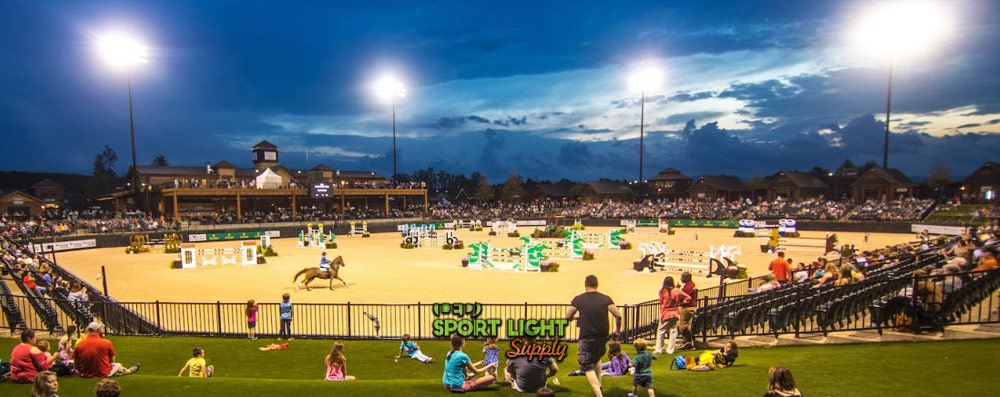
Outdoor Horse Arena Lighting Layout
Number of Poles
When designing the lighting layout for an outdoor horse arena, it is essential to determine the number of poles needed. Typically, a minimum of 4 to 6 poles is required, depending on the size of the arena. The height of each pole affects the beam angles, which influence how light disperses across the arena. To minimize light loss, consider the distance between the poles and the arena. The wattage of the fixtures must be adjusted based on the height of the poles and the distance from the arena. Proper planning ensures uniform lighting across the arena while addressing issues such as light pollution and glare.
Light Pole Height
The height of the light poles varies significantly, typically ranging from 6 to 18 meters. Taller poles generally improve light uniformity, but the effectiveness depends on the beam angles and the wattage of the fixtures used. The higher the pole, the narrower the beam angle should be to ensure uniform light distribution over greater distances. A precise formula can be used to calculate the appropriate pole height and beam angle, and professional assistance is available for this calculation.
Side Lighting vs. Corner Lighting
Side lighting enhances the overall visibility of the arena and reduces shadows that can be caused by corner lighting alone. For professional equestrian events, minimizing shadows on the horses enhances the visual appeal of the competition. Light poles can be strategically placed along the sidelines or at the corners of the arena. Smaller fill-in side lights can be added to complete the lighting setup. Side lighting is beneficial for both trainers and spectators, providing a clearer view of the horse’s movement and giving the arena a polished appearance.
Distance Between Light Poles and Sidelines
Maintaining adequate spacing between light poles is crucial for effective lighting. Each pole should be positioned 1 to 3 meters apart to ensure proper light dispersion and avoid an overcrowded appearance. This spacing helps prevent areas of uneven lighting, with some spots appearing brighter or weaker due to poor configuration. Following guidelines for light spacing and arrangement will result in a well-lit arena with consistent illumination across the entire surface. Sideline lighting should follow a similar spacing approach to achieve optimal lighting conditions.

Indoor Horse Arena Lighting Layout
Number of High Bay Lights
In an indoor horse arena, high bay lights should be arranged in a grid pattern to ensure even illumination. Typical configurations include groups such as 5×5, 7×5, or 8×6, where the numbers represent the arrangement of fixtures. For example, a 5×5 configuration would consist of 25 fixtures arranged in a grid. The exact number of rows and fixtures will vary based on the shape and size of the arena. The ceiling height and size of the facility will dictate the beam angle required to achieve optimal light uniformity.
Distance Between the Ceiling Floodlights
To achieve uniform lighting, floodlights should be spaced 2.5 to 4 meters apart, forming a grid pattern. This arrangement ensures that light coverage overlaps appropriately, reducing shadows and creating even illumination on the arena floor. The spacing of the floodlights is influenced by the height of the ceiling: taller ceilings require larger spacing to ensure adequate coverage, while lower ceilings necessitate shorter spacing to accommodate the reduced height.
Ceiling Height
The height of the ceiling in an indoor horse arena significantly impacts lighting design. Smaller venues typically have a ceiling height of around 5 meters, whereas larger venues may have heights up to 10 meters. Lower ceilings benefit from wider beam angles to spread light evenly, while high ceilings require narrower beam angles to control light distribution and minimize light pollution. Choosing the correct beam angle based on ceiling height is crucial to achieving effective lighting.
Type of Ceiling
Flat Ceiling
Flat ceilings are straightforward for mounting light fixtures. Fixtures are attached to support beams that may be metal or wood, depending on the building’s structure. This type of ceiling allows for easy installation of downlights or half-dome fixtures. A grid setup can be used to illuminate the arena floor evenly, with fixtures like UFO-shaped downlights or half-dome lights providing controlled beam angles for optimal coverage.
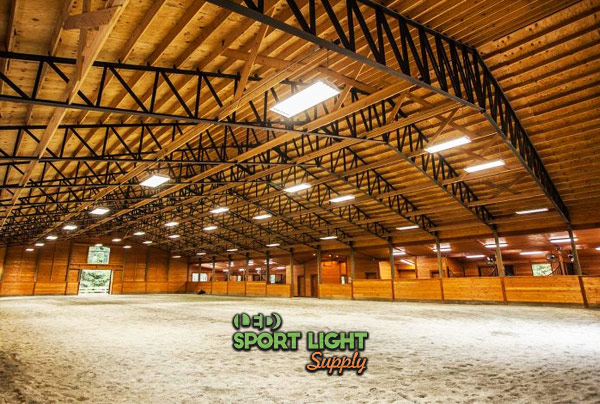
Vaulted Ceiling
Vaulted ceilings require more careful consideration when installing light fixtures. Special brackets are needed to ensure that floodlights point downward, regardless of the ceiling’s angle. Adjustable brackets allow for the correct beam direction and can accommodate various ceiling slopes. These brackets are also useful for side lighting, enabling precise placement of lights where additional coverage is needed.
Outdoor and Indoor Horse Arena Lighting Design and Standards
Lux and Brightness Requirement for Horse Arenas
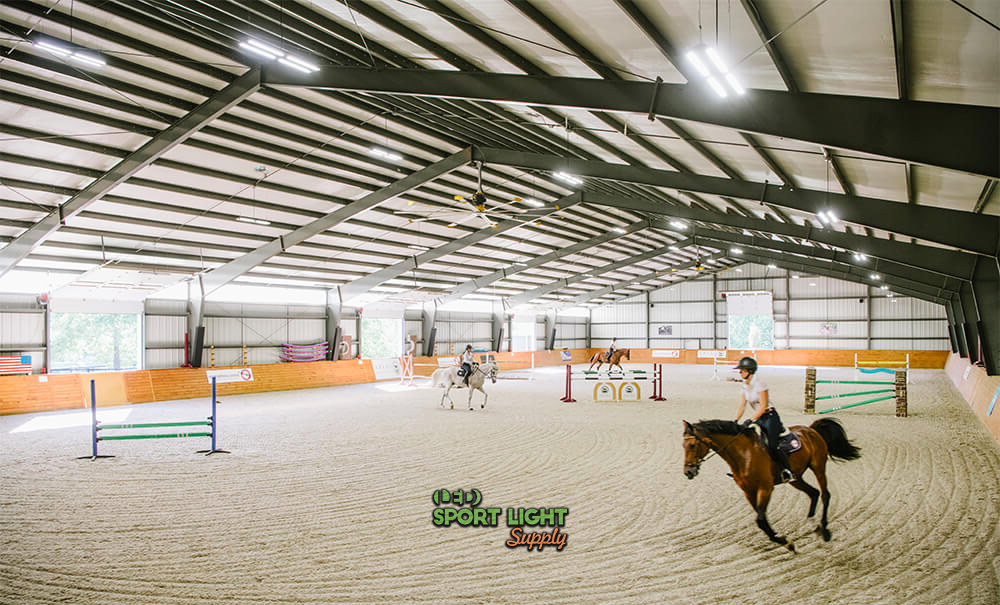
The lighting requirements for horse arenas vary based on the type of event and its level of professionalism. For recreational and training arenas, a Lux level of 100 to 200 is generally sufficient. This level provides adequate lighting for trainers to work with horses in both indoor and outdoor settings. For regional horse exhibitions and equestrian events at the club level, the Lux requirement increases to 200 to 300 to ensure better visibility and presentation.
For national and professional equine events, a minimum of 500 Lux is required. This higher Lux level is necessary to meet the standards for spectators and television broadcasts, ensuring high-quality lighting for both competition and media coverage.
Lighting Uniformity
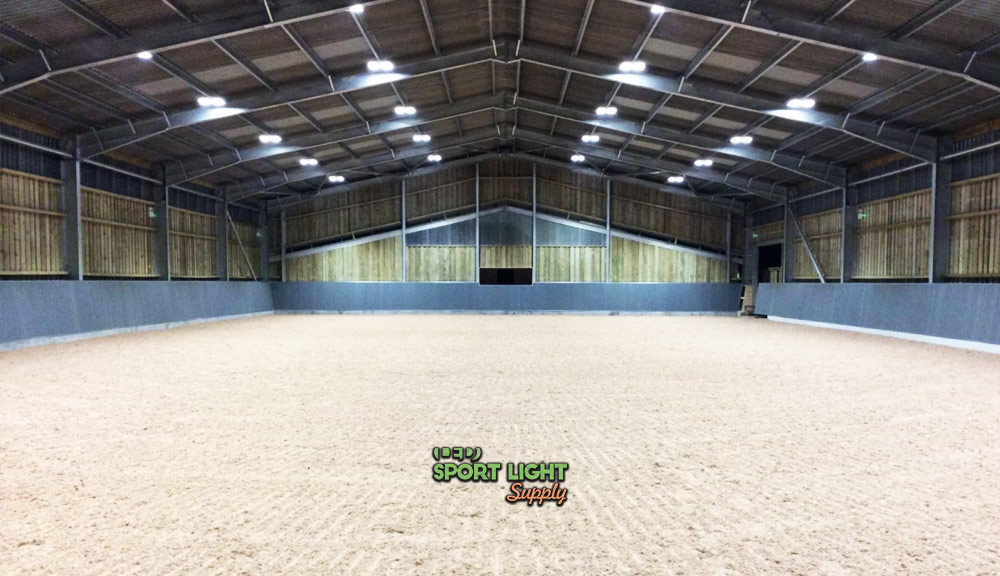
Lighting uniformity is crucial for competitive equestrian events to ensure consistent visibility and reduce eye strain. For a professional horse arena, the lighting uniformity should range between 0.5 and 0.7. This high level of uniformity minimizes shadows and glare, providing a comfortable viewing experience for both equestrians and spectators. The uniformity of lighting complements the Lux levels, contributing to an optimal visual environment.
Beam Angle
The beam angle used for lighting varies depending on the application. For outdoor arenas, beam angles of 10 or 25 degrees are suitable for long-range illumination, while 40, 60, or 90 degrees are used for short-range lighting. Narrower beam angles are necessary for long distances to ensure adequate light expansion.
In indoor arenas, where ceiling heights are lower, beam angles of 60 to 90 degrees are more appropriate. Wider beam angles help achieve even light distribution and reduce issues related to light spill and pollution.
Glare Rating
Glare can significantly impact both horses and riders, affecting performance and safety. Lighting designed for equestrian events should have a glare rating that balances visibility and comfort. Excessive glare can be distracting and potentially harmful. The glare rating should be set between levels of uncomfortable and barely noticeable on a scale of 1 to 9 to ensure optimal conditions for performance and viewing.
Color Rendering Index (CRI)
The Color Rendering Index (CRI) measures how accurately lighting reveals colors in comparison to natural light. In a horse arena, a high CRI is essential for showcasing the natural colors of horses and their movements. A CRI that is too high can lead to overexposure and unnatural color appearance, while a low CRI can make colors appear dim and underexposed. Achieving the correct CRI ensures that horses and riders are depicted naturally under arena lighting.
Color Temperature
Color temperature is crucial for both performance and media coverage. For major equine events, a color temperature of 5000K is recommended. This daylight-like temperature enhances detail and clarity for spectators and cameras. For practice and training sessions, a warmer color temperature of 2800K is suitable. This lower temperature provides a softer light that is comfortable for residential and backyard arenas.
Flicker-Free Lighting
Flickering lights can be problematic, particularly for older filament-style lamps. LED lights are preferred for their reduced flicker issues, as they operate with fewer visible flashes per second. At a professional level, using LED lights helps minimize flicker and provides stable, consistent illumination. Older lighting systems may require additional flicker control methods, such as high-quality ballasts, to manage flicker and maintain effective lighting performance.
Advantages of Using LED Lighting for Horse Arenas
Reduced Running Costs
LED lighting is renowned for its energy efficiency, with a luminous efficacy of approximately 150 lumens per watt. This is significantly higher compared to traditional lighting options like HID, metal halide, or mercury vapor lamps. These older lighting technologies often require higher wattages to produce the same amount of light, leading to increased energy consumption and higher operational costs. Additionally, the frequent replacement of filaments in traditional lights adds to the overall expense. LED lights, on the other hand, offer substantial cost savings due to their efficiency, allowing equine trainers and facility owners to allocate their budgets more effectively.
Lower Maintenance Costs
LED lights boast an impressive lifespan of over 150,000 hours. This extended longevity means that replacements are infrequent, reducing maintenance efforts and costs. For those involved in horse training and equestrian sports, this longevity translates into fewer disruptions and lower long-term expenses. Given the rising costs associated with horse breeding and equine activities, the durability of LED lights offers significant financial relief. By investing in LED technology, facility owners can enhance their budget management without compromising on lighting quality.
Flicker-Free and Low Glare
LED lights are designed to operate without noticeable flicker, which is beneficial for both horses and riders. The human eye cannot detect the rapid flicker that occurs with LED lights, and high-speed cameras used in broadcasting can filter out any imperceptible flashes. This flicker-free operation ensures a more stable and comfortable lighting environment, minimizing distractions and potential discomfort for horses and riders during performances.
Low Heat Generation
One of the key advantages of LED lighting is its efficient heat management. LED fixtures are equipped with heat sinks that absorb and dissipate excess heat generated by the light source. This effective heat dissipation prevents the fixtures from overheating, which can be a concern with traditional filament lights. For equine performances, this means that the lighting does not contribute additional heat to the arena, helping to maintain a comfortable environment for horses and preventing heat-related fatigue.
Color-Changing Function
LED lights offer the exciting capability of color-changing, which can enhance the visual appeal of equine events. With fixtures capable of displaying red, green, and blue colors, LED systems can be programmed to create a wide range of hues and effects. This functionality can be controlled through various devices, including smartphones, allowing for dynamic and entertaining light displays. Such features can add an engaging element to equestrian events, making them more visually captivating for audiences.
Conclusion
LED lighting brings numerous benefits to horse arenas, including cost savings, reduced maintenance, and enhanced visual quality. The technology not only improves lighting efficiency but also contributes to a better experience for both horses and spectators. If you have any questions or need further assistance with lighting design and layout for your arena, please feel free to contact us. We are here to help you leverage the advantages of LED lighting to elevate the professionalism and effectiveness of your equestrian activities.
